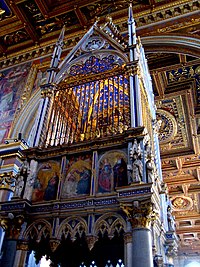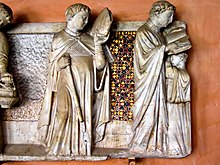art.wikisort.org - Artist
Arnolfo di Cambio[1] (c. 1240 – 1300/1310[2]) was an Italian architect and sculptor. He designed Florence Cathedral and the sixth city wall around Florence (1284–1333),[3] while his most important surviving work as a sculptor is the tomb of Cardinal de Braye in S. Domenico, Orvieto.[4]
Arnolfo di Cambio | |
|---|---|
 Arnolfo di Cambio by Vasari | |
| Born | Arnolfo di Lapo 1232/1240 Colle di Val d'Elsa |
| Died | 8 March 1302/1310 |
| Nationality | Italian |
| Occupation | Architect and sculptor |


Biography
Arnolfo was born in Colle Val d'Elsa, Tuscany.

He was Nicola Pisano’s chief assistant on the marble Siena Cathedral Pulpit for the Duomo in Siena Cathedral (1265–1268), but he soon began to work independently on an important tomb sculpture. In 1266–1267 he worked in Rome for King Charles I of Anjou, portraying him in the famous statue housed in the Campidoglio. Around 1282 he finished the monument to Cardinal Guillaume de Braye in the church of San Domenico in Orvieto, including an enthroned Madonna (a Maestà) for which he took as a model an ancient Roman statue of the goddess Abundantia; the Madonna's tiara and jewels reproduce antique models.[5] In Rome Arnolfo had seen the Cosmatesque art, and its influence can be seen in the intarsia and polychrome glass decorations in the Basilica of Saint Paul Outside the Walls and the church Santa Cecilia in Trastevere, where he worked in 1285 and 1293 respectively. In this period he also worked on the presepio of Santa Maria Maggiore, on Santa Maria in Aracoeli, on the monument of Pope Boniface VIII (1300) and on the bronze statue of St. Peter in St. Peter's Basilica.
In 1294–1295 he worked in Florence, mainly as an architect. According to his biographer Giorgio Vasari, he was in charge of construction of the cathedral of the city, for which he provided the statues once decorating the lower part of the façade destroyed in 1589. The surviving statues are now in the Museum of the Cathedral. While the design of the Church of Santa Croce has been attributed to Arnolfo, this is highly disputed. Vasari also attributed to him the urban plan of the new city of San Giovanni Valdarno.
The monumental character of Arnolfo's work has left its mark on the appearance of Florence. His funerary monuments became the model for Gothic funerary art.
Giorgio Vasari included a biography of Arnolfo in his Lives of the Most Excellent Painters, Sculptors, and Architects.
Selected works
Architecture
- Santa Maria del Fiore, Florence Cathedral, 1296. Arnolfo's design was extended and completed by other architects in the 14th and 15th centuries.[6]
- Palazzo Vecchio in Florence, 1299.[7]

Sculpture
- St. Peter Enthroned inside St. Peter's Basilica, is often attributed to Arnolfo.[8]
- Monument to Pope Adrian V (1276, attributed) – San Francesco, Viterbo
- Monument to Riccardo Cardinal Annibaldi (1276) – San Giovanni in Laterano, Rome[9]
- Statue of Charles I of Anjou (1277) – Campidoglio, Rome[10]
- Fountain of the Thirsty People (Fontana Minore) – Perugia[11]
- Tomb of Cardinal Guillaume de Braye (c. 1282) – San Domenico, Orvieto[12]
- Monument of Pope Boniface VIII – the Museo dell'Opera del Duomo – Florence
Footnotes
- The name "Arnolfo di Lapo" by which he is mentioned in some sources was an invention by his biographer Giorgio Vasari. See Tomasi, 2007.
- The traditional date of 1302 has been recently discovered to be wrong. See Tomasi, 2007.
- "Firenze-Oltrarno.net: City Walls".
- Oxford illustrated encyclopedia. Judge, Harry George., Toyne, Anthony. Oxford [England]: Oxford University Press. 1985–1993. p. 22. ISBN 0-19-869129-7. OCLC 11814265.
{{cite book}}: CS1 maint: others (link) - Roberto Weiss, The Renaissance Discovery of Classical Antiquity (Oxford: Blackwell) 1973:14 note 2.
- Heck, Johann Georg (1856). The Art of Building in Ancient and Modern Times, Or, Architecture Illustrated. Vol. 1. D. Appleton. p. 182.
- Norman, Diana (1995). Siena, Florence, and Padua: Case studies. Yale University Press. p. 43. ISBN 9780300061260.
- Thomson de Grummond, Nancy (11 May 2015). Encyclopedia of the History of Classical Archaeology. Routledge. p. 84. ISBN 9781134268542.
- Gardner, Julian (March 1972). "The Tomb of Cardinal Annibaldi by Arnolfo di Cambio". The Burlington Magazine. Burlington Magazine Publications Ltd. 114 (828): 136–141. JSTOR 876902.
- Abulafia, David (2000). "Charles of Anjou reassessed". Journal of Medieval History. Tandfonline. 26 (1): 93–114. doi:10.1016/S0304-4181(99)00012-3. S2CID 159990935.
- Gilbert, Creighton (1972). History of Renaissance Art: Painting, Sculpture, Architecture Throughout Europe. H.N. Abrams. p. 24. ISBN 9780810901698.
- Krén, Emil; Marx, Daniel. "Tomb of Cardinal de Braye". Web Gallery of Art. Retrieved 26 September 2018.
Sources
- Tomasi, Michele (February 2007). "Lo stil novo del Gotico italiano". Medioevo (121): 32–46.
External links
На других языках
[de] Arnolfo di Cambio
Arnolfo di Cambio (* um 1240/45 in Colle di Val d’Elsa; † 1302/1310 in Florenz) war ein italienischer Architekt und gotischer Bildhauer. Von Giorgio Vasari wurde er fälschlicherweise als „Arnolfo di Lapo“ bezeichnet, da er annahm, dass der Vater von Arnolfo ein deutscher Baumeister namens Lapo sei.- [en] Arnolfo di Cambio
[es] Arnolfo di Cambio
Arnolfo di Lapo, también conocido como Arnolfo di Cambio, (1232 o 1245 – 1310) fue un arquitecto y escultor florentino. Su obra arquitectónica incluye el proyecto de la catedral de Santa María del Fiore, en Florencia (1294) y la Basílica de Santa Cruz, en la misma ciudad; y la catedral de Orvieto en Italia.[fr] Arnolfo di Cambio
Arnolfo di Cambio ou Arnolfo di Lapo est un architecte, un sculpteur et peut-être un peintre, né à Colle di Val d'Elsa (province de Sienne) autour de 1245, et mort à Florence le 8 mars d'une année imprécisée entre 1302 et 1310[1].[it] Arnolfo di Cambio
Arnolfo di Cambio, noto anche come Arnolfo di Lapo[1] (Colle di Val d'Elsa, 1245 circa[2] – Firenze, 8 marzo tra il 1302 e il 1310 circa[3][4]), è stato uno scultore, architetto e urbanista italiano attivo in particolare a Roma e a Firenze alla fine del Duecento e ai primi del secolo successivo.[ru] Арнольфо ди Камбио
Арно́льфо ди Ка́мбио (итал. Arnolfo di Cambio; ок. 1245 — до 1310, Флоренция) — итальянский скульптор и архитектор, представитель Проторенессанса.Другой контент может иметь иную лицензию. Перед использованием материалов сайта WikiSort.org внимательно изучите правила лицензирования конкретных элементов наполнения сайта.
WikiSort.org - проект по пересортировке и дополнению контента Википедии